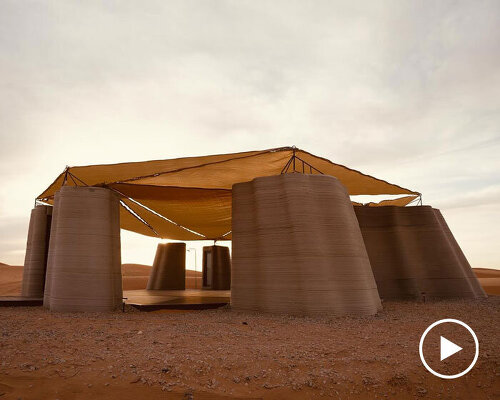Modular 3D Printed Camp Designed for Reforestation Volunteers
China’s first 3D printed concrete structure in a desert environment, Desert Ark by designRESERVE, serves a dual purpose: supporting ecological restoration efforts in Inner Mongolia and testing a construction model adaptable to future extreme or extraterrestrial environments. Located on the edge of the Tengger Desert, one of China’s largest arid regions, the project was commissioned by a non-profit organization leading long-term reforestation efforts to control desertification. Since the 1990s, volunteers have worked to contain the desert’s eastward expansion through continuous tree-planting campaigns. The new field camp provides accommodation and operational facilities for these volunteers, known as the ‘Rangers of the Desert-Locking Forest,’ offering protection and functional support under harsh environmental conditions.
The campsite comprises nine modular units that together form a self-contained, 150-sqm facility. Each module accommodates a specific function, living area, kitchen, restrooms, shower, and storage, organized around a central wooden deck that acts as a communal and circulation space. The arrangement forms an enclosed cluster called the Desert Ark, designed to provide shelter from high winds and sandstorms while maintaining a visual and physical openness to the landscape.
The design and construction process were structured in six phases. Prefabricated modular concrete units were produced using Robotic 3D Concrete Printing (R3DCP) technology in Wuxi before being transported by truck to the desert. On-site assembly was carried out with the assistance of local herders. The foundation was prepared using reusable cargo pallets to minimize ground disturbance, followed by the installation of a wood–plastic composite deck and retractable canopy for shading. Finally, low-emissivity glazing, solar panels, and water systems were integrated to ensure full off-grid functionality. All concrete modules were assembled within two days using standard vehicles and minimal site labor.
aerial view of Desert Ark with lake and solar panels | all images by ©️ATDEF team unless stated otherwise
3D Printed Sand-Based Modules Reflect Mongolia’s Desert Setting
The modules are produced with 3D printed concrete whose primary component is a sand-based mixture, aligning both materially and visually with the surrounding dunes. The undulating forms of the units minimize wind resistance, while the textured printed surface reflects the natural patterns of the landscape. Each unit sits directly on the sand and stabilizes through its own weight, avoiding deep foundations and enabling reversible construction for future relocation. The wooden deck, supported by tied steel pipes and reused cargo pallets, creates a continuous platform that appears to float above the ground, further reducing environmental impact.
Studio designRESERVE achieves environmental performance through passive and off-grid strategies. Thermal comfort is maintained by the cavity structure of the printed concrete walls, providing insulation during winter, when temperatures can drop to minus 30 degrees Celsius, and heat resistance in summer, when daytime temperatures reach up to 45 degrees. The retractable canopy reduces solar heat gain, eliminating the need for active air conditioning. A biodegradable septic system collects and filters wastewater for irrigation, achieving complete reuse for vegetation. The entire site operates on a solar-powered system, ensuring zero carbon emissions.
Desert Ark demonstrates the potential of 3D concrete printing for rapid, resilient, and low-impact construction in extreme environments. The modular and prefabricated system supports ecological restoration efforts while serving as a research prototype for adaptable architecture in remote or extraterrestrial settings. By combining robotic fabrication, material efficiency, and environmental performance, the project proposes a scalable model for sustainable habitation where traditional construction is unfeasible.
Desert Ark viewed over the lake
aerial view of Desert Ark with lake
Desert Ark with canopy installed
shower and kitchen capsules
project info:
name: Desert Ark
designer: designRESERVE | @design_reserve
design team: Fangzhou Lydia Song, Feng Yue, Jingning Huang, Yanbo Xu
location: Alxa County, Inner Mongolia, China
area: 150 sqm
photographer: Rangers of Desert-Locking Forest, Huaer Lin, Yong Hu, ATDEF team
designboom has received this project from our DIY submissions feature, where we welcome our readers to submit their own work for publication. see more project submissions from our readers here.
edited by: christina vergopoulou | designboom
The post 3D printed concrete habitat shelters reforestation volunteers from mongolia’s desert environment appeared first on designboom | architecture & design magazine.

